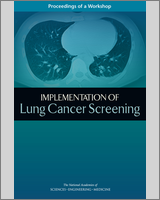NCBI Bookshelf. A service of the National Library of Medicine, National Institutes of Health.
National Academies of Sciences, Engineering, and Medicine; Health and Medicine Division; Board on Health Care Services; National Cancer Policy Forum. Implementation of Lung Cancer Screening: Proceedings of a Workshop. Washington (DC): National Academies Press (US); 2016 Nov 17.
- Coinsurance–
the percentage of costs of a covered health care service that a patient is responsible for once the deductible has been paid (HealthCare.gov, 2016).
- Decision aids–
tools used to facilitate a shared decision-making conversation between a patient and clinician. These tools can help patients understand the clinical evidence and help them identify their preferences. Decision aids do not advise people to choose one option over another; instead, they help prepare patients to make informed decisions aligned with their values and preferences (Healthwise, 2016).
- False negative–
a person who has a disease but receives a negative test result.
- False positive–
a person who does not have a disease but receives a positive test result.
- Incidental findings–
clinical findings that are identified during diagnostic testing but are not related to the diagnostic test result (for lung cancer screening, this could include cardiac abnormalities, chronic obstructive pulmonary disease, aneurysms, or masses in other tissues).
- Lead-time bias–
an overestimation of a patient's survival benefit among individuals without symptoms who are screened for cancer, compared to individuals with cancer that are detected by signs and symptoms when survival is measured from the time of diagnosis (American College of Physicians, 1999).
- Length-time bias–
an overestimation of a patient's survival duration among individuals without symptoms who are screened for cancer due to the disproportionate number of slowly progressing cancers that will be detected (American College of Physicians, 1999).
- Number needed to screen–
the number of people who need to be screened to prevent one bad outcome.
- Overdiagnosis–
when a condition is diagnosed that would otherwise not go on to cause symptoms or death (Welch and Black, 2010, p. 605).
- Pack-year–
a way to measure the amount a person has smoked over a long period of time. It is calculated by multiplying the number of packs of cigarettes smoked per day by the number of years the person has smoked. For example, 1 pack-year is equal to smoking 1 pack per day for 1 year, or 2 packs per day for half a year, and so on (NCI, 2016).
- Positive predictive value–
the probability that individuals with a positive test result actually have the disease. True Positives/(True Positives + False Positives)
- Screening–
checking for disease when there are no symptoms. Because screening may find diseases at an early stage, there may be a better chance of curing the disease (NCI, 2016).
- Sensitivity–
the proportion of people with a disease who are correctly identified from all positive test results for the disease. True Positives/(True Positives + False Negatives)
- Shared decision making–
is a collaborative process that allows patients and their providers to make health care decisions together. It takes into account the best clinical evidence available, as well as the patient's values and preferences. Shared decision making is not a goal. The goal is better health decisions to achieve outcomes that matter most to the patient. And shared decision making is a way to reach that goal. A proven process to incorporate the patient's voice in health care decisions, shared decision making is the pinnacle of patient-centered care (Healthwise, 2016).
- Specificity–
the proportion of people who are correctly identified as not having a disease from all negative test results for the disease. True Negatives/(True Negatives + False Positives)
REFERENCES
- American College of Physicians. Finding and redefining disease. 1999. [September 30, 2016]. http://ecp
.acponline .org/marapr99/primer.htm. - Coinsurance. 2016. [September 30, 2016]. HealthCare
.gov. https://www .healthcare .gov/glossary/co-insurance. - Healthwise. Why shared decision making? 2016. [August 29, 2016]. http://www
.informedmedicaldecisions .org/shareddecisionmaking.aspx. - IOM and NRC (Institute of Medicine and National Research Council). Mammography and beyond: Developing technologies for the early detection of breast cancer. Washington, DC: National Academy Press; 2001.
- NCI (National Cancer Institute). NCI dictionary of cancer term. 2016. [September 19, 2016]. https://www
.cancer.gov /publications/dictionaries /cancer-terms. - Welch HG, Black WC. Overdiagnosis in cancer. Journal of the National Cancer Institute. 2010;102(9):605–613. [PubMed: 20413742]
- PubMedLinks to PubMed
- Glossary - Implementation of Lung Cancer ScreeningGlossary - Implementation of Lung Cancer Screening
Your browsing activity is empty.
Activity recording is turned off.
See more...
